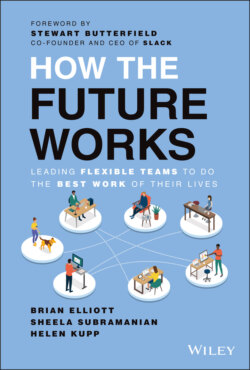Читать книгу How the Future Works - Brian Elliott - Страница 13
What We Mean by Flexible Work
ОглавлениеHybrid, remote, virtual, distributed … these are all terms you will hear associated with the concept of flexible work, and they all describe work models that differ from the traditional setup that has been the default way in which so many people have worked for decades. For the purposes of this book, we lump them all together under the umbrella heading of “flexible work” (but with an important caveat that we'll get to in a moment).
That's because “flexible work” has a somewhat flexible definition. It encompasses a wide range of options that can be tailored to meet the needs of your company, or even the needs of different teams within your company. And yet far too often people define it far too narrowly. They think only of those employees who sometimes or always work from home (WFH) even though that's just one, rather narrow definition (and, as you will come to learn, typically not the most beneficial one). Flexible work, in our view, is more of a mindset than a specific set of rules or policies. It's about freeing oneself from the outdated notion that work = office and the workweek = 9-to-5. Instead we can push the boundaries of how we think about the ways in which we can work together and offer people more freedom and autonomy to get things done in ways that suit them better. We can choose to focus on which model is going to drive the best outcomes for our business, rather than on where and when that work takes place. This requires some flexible thinking.
For example, the reason why WFH is generally not the most beneficial version of flexible work is because the when is actually more important than the where. You see, most of the time when people talk about flexibility, they talk about location—and, in fact, most of the common terms we just mentioned, like remote and distributed, largely suggest this kind of flexibility. But schedule flexibility is actually far more important. A Future Forum survey of more than 10,000 knowledge workers across six countries found that 76% want flexibility in where they work. That's a significant number, one worth paying attention to, but, perhaps surprisingly, it's not even the kind of flexibility that workers want most. A whopping ninety-three percent of workers said they want flexibility in when they work (see Figure 2).2
Figure 2
Source: Future Forum Pulse, 2021
As you make your way through this book, we invite you to keep an open mind about what flexible work can mean because we have found that those statistics defy expectations for a lot of leaders. Even the most innovative companies, the ones that embrace location flexibility, have struggled with the concept of schedule flexibility. But let's face it: a calendar full of back-to-back meetings from 9:00 a.m. to 5:00 p.m., even when done via Zoom from a home office, is not real flexibility, and it's not what workers are asking for. They want the ability to coordinate schedules with their partners and kids. They want to be able to take time out of their day to rest, workout, or go to an appointment. They want to be able to work on a schedule that allows them to be the most productive. They want the freedom and autonomy to make their lives work and do good work all at the same time.
The numbers also show that the desire for flexibility defies stereotype. It's not just something for younger employees or working moms. The desire crosses age, gender, race, and geographical categories. Even among executives, who expressed a preference for office work, a majority still valued their schedule flexibility.
Because the vast majority of workers are asking for it might be reason enough to consider changing how you work, but it's hardly the only reason. When done right, flexible work offers numerous benefits that can give your organization a real competitive edge.
